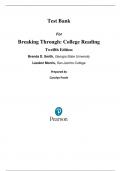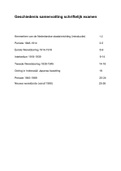Test Bank
For
M
Breaking Through: College Reading
E
Twelfth Edition
D
C
Brenda D. Smith, Georgia State University
O
LeeAnn Morris, San Jacinto College
N
Prepared by
N
Carolyn Poole
O
S I
E S
U
R
,NAME DATE SCORE
CHAPTER 1: Student Success
TEST A
Answer the multiple-choice questions based on the content of the chapter.
1. According to the text, one of the most important factors for a successful college experience is
M
a. obtaining a high school diploma.
b. maintaining a passing grade point average.
c. an attitude for success.
E
2. The way successful people manage to get more done is that they
D
a. manage their use of time.
C
b. have lunch regularly with successful businesspeople.
c. work on Saturday.
O
3. According to the text, how often should a student make a to-do list?
a. daily
b. once a week
N
c. once a month
N
4. According to the text, all of the following are keys to academic success except
O
a. currying favor with the professor.
I
b. being prepared by reading the syllabus.
S
c. marking your textbook.
5. Test preparation enhances
S
a. self-confidence. b. speed reading. c. anxiety.
E
6. After your test is returned, you should review it
U
a. because the instructor suggested it. b. to challenge the grade. c. to learn from your errors.
R
7. Main idea questions are designated by such words or phrases as
a. “suggests” / “implies.”
b. “it is stated” / “the author asserts.”
c. “primarily concerned with” / “central focus.”
8. The best strategy for finding the answer to a detail question is to
a. reread the first sentence and determine the topic.
b. find a key word in the question options, and then find the same word in the passage.
c. skim the passage to understand the gist of the passage.
1
Copyright © 2019, 2016, 2013 Pearson Education, Inc. All rights reserved.
,9. “Drawing a conclusion” is categorized as what type of question?
a. inference b. detail c. stated main idea
10. To answer vocabulary in context, a student should
a. break down the word into parts and try to recognize the root.
b. reread the passage to be certain s/he covered all the context.
c. reread the sentences before and after the word, as well as the sentence the word is in.
M
11. A student can simplify an essay question by
E
a. noticing key words in the question.
b. asking another student for clarification.
D
c. writing a brief summary of the material before writing the essay.
12. True False Efficient readers know that the most important reading goal is reading the material as fast as
C
possible.
O
13. An increase in reading speed usually means
a. an improvement in comprehension. N
b. poorer comprehension. c. slower eye movements.
14. An example of an external distraction would be
N
a. worrying about money. b. visualizing during the reading process. c. a telephone call.
O
15. Reading a selection on economics should take
S I
a. more time than reading a popular magazine article.
b. less time than reading a popular magazine article.
c. the same amount of time as reading a popular magazine article.
E S
U
R
2
Copyright © 2019, 2016, 2013 Pearson Education, Inc. All rights reserved.
, TEST B: ESSAY
Choose either the selection on Optimism or the selection on Classroom Behavior and respond to the questions that follow in
your essay response. Be sure to support your opinion or points with examples.
Optimism
Optimism, a positive state of mind, is really more an outlook, a view that has to do with how you explain the bad
things that happen in your life, which in turn can keep you from becoming depressed or demoralized in the face of setbacks.
M
In failing an exam, for example, some people would say they failed because they are stupid. They explain it in terms of some
fixed, permanent trait in themselves. (That’s the negative or pessimistic view.) Others would say they failed because it was a
very hard test, but next time they’ll study harder. They explain bad things happening in terms of a constantly changing
E
situation—not a permanent flaw within themselves. They are hopeful that things will be different next time.
In one study started in the 1940s, students at Harvard University were classified as pessimists or optimists based on
D
essays they had written explaining events in their lives. About thirty years later, the health history of these same students was
examined. Starting in their forties, the pessimists had more serious diseases and health problems than the optimists.
—Goleman, 1997, pp. 40–41
C
Question: How has pessimism blocked you from your dreams in the past? Give three specific examples. Looking back at
O
these situations now, how could an optimistic view have helped you through the situations? That is, how would you have
handled the situations differently? Do you believe that a negative outlook in life and/or stressful situations can lead to health
problems? Why or why not? N
N
Behavior in the Classroom.
Your body has its own language in class and can communicate a lot, even if you rarely say a word. You want to be
O
comfortable, but if you prop your feet up on another desk, lean your head on the wall, or slump forward, you will look
inattentive. Avoid sitting back with your arms folded because you obviously aren’t taking notes and can even be perceived as
aggressive or defiant, especially if you look unhappy and bored.
I
Use facial expressions and eye contact to demonstrate interest and attention. Watch the teacher unless you are taking
S
notes, and if the teacher catches your eye, don’t look away. You can even use body language to participate in class, which
can be a particularly helpful technique for the shy or unprepared student. As your teacher or classmates talk, focus on them.
Don’t fidget. Tapping pens, pointedly looking at your watch, shifting around restlessly in your seat, getting out your keys—
S
this kind of body language is distracting.
Remember to behave as you would if you and the teacher were the only people in the room. You wouldn’t stare out
E
the window, fail to respond to a question, or go to sleep, would you? Strive to impress the teacher with your qualities as a
student. A pleasant, attentive expression and good posture can go a long way toward making a good impression.
U
—Arthur, et al., 1996, pp. 23; 25–26
Question: Try to recall classmates who did not like to go to class. What kind of behaviors did they exhibit to call attention to
R
the fact that they did not like the class? Was the teacher aware that these students did not like the class? At the time, did you
consider these students to be “acting successfully”? What kind of grades did they earn? What did you learn from their
actions and the consequences of their actions? Be sure to address the question of how you could improve your behavior in
the classroom.
3
Copyright © 2019, 2016, 2013 Pearson Education, Inc. All rights reserved.





